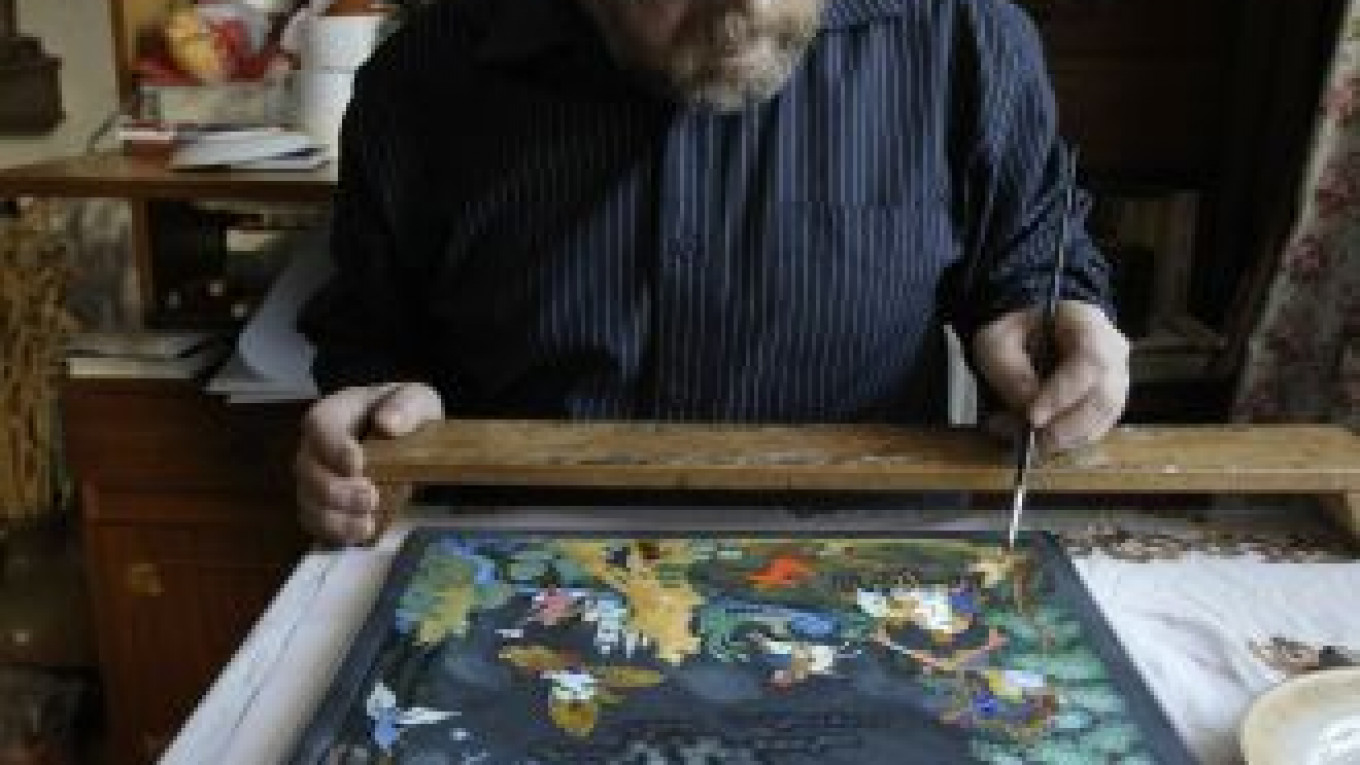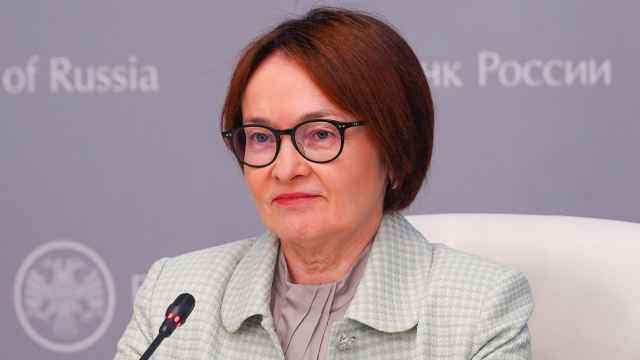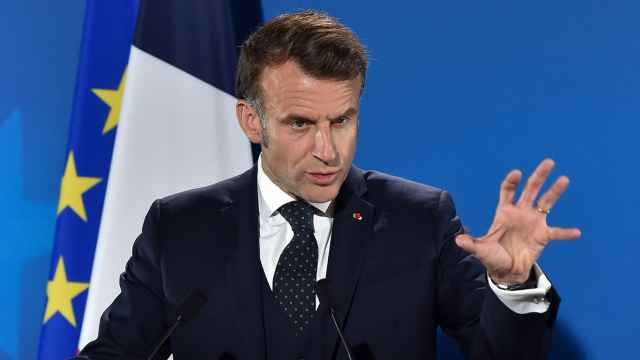PALEKH, Ivanovo Region — A squirrel tail. Wolf teeth. Sheets of gold. Flax oil.
These are the things Vladimir Buldakov uses to work a feat of modern-day alchemy: transforming an ordinary papier-mache box into a gilded miniature masterpiece that will tell the story of saints or heroes, fairies or dragons.
Buldakov comes from Palekh, a 700-year-old village where a church's lavender onion-domes overlook snow-clad houses, a frozen river and a distant birch forest. The town is famous for its beauty, but the rare outsiders who visit come for the varnished boxes that bear its name.
Now, the unique art form, which emerged in the 1920s after the atheist Bolsheviks approved a new medium in which masters of religious icon paintings could use their talents, is struggling to find a reason to exist in capitalist society.
If it disappears entirely, its stunted lifespan will bear vivid testament to the twists of Russia's turbulent recent history. And Russia will lose one if its hallmark trinkets, the product of an astonishingly high-skilled process.
In Palekh, the 60-year-old Buldakov's fine brush is made from a squirrel caught in August — any later and the fur splits. He boils the papier-mache in flax oil to make it stone hard. After painting and varnishing, he applies tiny specks of gold kneaded in gum arabic, and smoothes the surface with a wolf's tooth.
The box will take months to complete. For the backbreaking labor, he will be lucky to get a few thousand dollars. Buldakov and his wife, Natalya, are masters of their craft; less talented artists struggle to command a couple hundred dollars a box.
With demand falling, that's hardly enough to keep his daughter Ksenia keen on carrying on a family tradition that goes back five generations. She trained as a Palekh box painter but moved to St. Petersburg to make dolls at a puppet theater, which is less arduous.
"It doesn't make sense to work with the boxes," the 30-year-old says, adding that most others of her generation feel the same way. "Very few of them stay. … Everyone wants to get out. It's cramped and boring."
Back in Soviet times, Palekh boxes were a heavily subsidized art that made their makers relatively rich. But in these days of globalization and free-wheeling capitalism, where oil oligarchs have become some of the world's richest men, the lure of making boxes for modest earnings that dwindle every year is fading fast.
Even young people who like Ksenia Buldakova graduated from the Palekh art college, where her father teaches, now work as software designers, cartoonists, teachers and even manicurists, astounding clients with the intricate details their studies allow them to paint on nails.
Palekh is not alone on the list of famous village handicrafts — wooden toys from Bogorodsk, blue majolica ceramics from Gzhel, iron trays from Zhostovo, to name a few — that may soon become history.
The trend runs deeper because traditional ways that Russians eat, dress and dance are also fading.
It's hard to find the massive wood-fired brick ovens that once dominated each household. They were essential for steam baths and traditional cooking, and their replacement gas stoves made "a whole class of traditional Russian foods extinct," according to food historian Vilyam Pokhlyobkin.
Teenagers shun traditional valenki felt boots in favor of Chinese-made sneakers and sneer at traditional folk music and dance; aspiring musicians prefer electric guitars and synthesizers to accordions and balalaikas — decimating the ranks of their makers.
Artisans blame the decline in Russian crafts largely on an industrial recession in a country where plants and factories can compete neither with the sophistication of Western technologies nor the cheapness of Chinese manufacturing.
"Matryoshkas are now made in China and brought here," said Sofia Panfilova, the 54-year-old owner of a souvenir shop outside the Kremlin, who has also been painting these nesting dolls for more than 20 years.
Palekh painters don't advertise their works online for fear that their designs will be replicated on high-resolution prints glued to boxes, then varnished. One artist, Nikolai Kukuliyev, recalled how his stout, white-bearded father, Boris, angrily rushed out of a Moscow souvenir shop after seeing a knockoff box with his design.
"Why is the grandpa mad at me? I'll give him a good discount for the box," the salesman told Kukuliyev.
"Grandpa was the author," Kukuliyev shot back.
Perhaps most fatal has been the drying up of lavish state subsidies. The Palekh miniature emerged and flourished because communist ideologues chose it as a poster child of Soviet art. For centuries, Palekh was a center of icon painting, but after the 1917 Bolshevik revolution, artists switched to secular scenes and the nascent communist propaganda.
Soviet leaders were flattered to see themselves painted as martyrs and saints. Back then, Palekh masters and other centers of handicrafts enjoyed benefits, state medals and scrupulous attention from culture officials who had to approve each sketch.
Across Russia, artisans' villages were often islands of prosperity surrounded by an ocean of dirt-poor collective farms. A government monopoly also sold most of the artistic output abroad or in specialized shops for foreign tourists.
"Sales were not our headache," said Maxim Churikov, director of the Fedoskino factory outside Moscow that, like Palekh, produces lacquered boxes often encrusted with fragments of mother-of-pearl, silver or gold.
The 1991 Soviet collapse brought artistic freedom, including a return to religious themes, and an unprecedented boom for Palekh, whose miniatures were sought after by foreign museums and collectors.
But the boom ended in bust, as Western demand for Palekh boxes dwindled. Few handicraft centers these days enjoy state financial support, meaning that it's hard to survive without proximity to Moscow that brings buses of foreign tourists or affluent Russian weekenders. Palekh lies 340 kilometers northeast of Moscow, a bumpy five-hour drive.
The return to religious themes also dealt a blow to Palekh miniatures. As the triumphant Russian Orthodox Church began reopening thousands of churches and monasteries across the nation, the demand for icons soared, prompting many students at the Palekh art college to take up the once-forgotten art.
But Palekh artists say icons that have to be thoughtlessly copied from ancient originals leave no room for creativity. "There is a danger we might turn into a school of icon painters," said college director Mikhail Belousov.
A Message from The Moscow Times:
Dear readers,
We are facing unprecedented challenges. Russia's Prosecutor General's Office has designated The Moscow Times as an "undesirable" organization, criminalizing our work and putting our staff at risk of prosecution. This follows our earlier unjust labeling as a "foreign agent."
These actions are direct attempts to silence independent journalism in Russia. The authorities claim our work "discredits the decisions of the Russian leadership." We see things differently: we strive to provide accurate, unbiased reporting on Russia.
We, the journalists of The Moscow Times, refuse to be silenced. But to continue our work, we need your help.
Your support, no matter how small, makes a world of difference. If you can, please support us monthly starting from just $2. It's quick to set up, and every contribution makes a significant impact.
By supporting The Moscow Times, you're defending open, independent journalism in the face of repression. Thank you for standing with us.
Remind me later.






